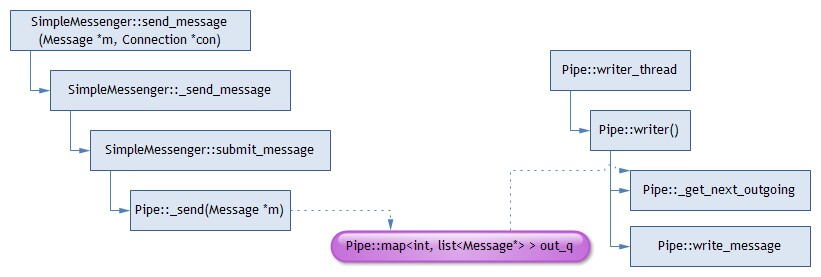由于Ceph的历史很久,网络没有采用现在常用的事件驱动(epoll)的模型,而是采用了与MySQL类似的多线程模型,每个连接(socket)有一个读线程,不断从socket读取,一个写线程,负责将数据写到socket。多线程实现简单,但并发性能就不敢恭维了。
Messenger是网络模块的核心数据结构,负责接收/发送消息。OSD主要有两个Messenger:ms_public处于与客户端的消息,ms_cluster处理与其它OSD的消息。
数据结构

网络模块的核心是SimpleMessager:
(1)它包含一个Accepter对象,它会创建一个单独的线程,用于接收新的连接(Pipe)。
void *Accepter::entry()
{
...
int sd = ::accept(listen_sd, (sockaddr*)&addr.ss_addr(), &slen);
if (sd >= 0) {
errors = 0;
ldout(msgr->cct,10) << "accepted incoming on sd " << sd << dendl;
msgr->add_accept_pipe(sd);
...
//创建新的Pipe
Pipe *SimpleMessenger::add_accept_pipe(int sd)
{
lock.Lock();
Pipe *p = new Pipe(this, Pipe::STATE_ACCEPTING, NULL);
p->sd = sd;
p->pipe_lock.Lock();
p->start_reader();
p->pipe_lock.Unlock();
pipes.insert(p);
accepting_pipes.insert(p);
lock.Unlock();
return p;
}
(2)包含所有的连接对象(Pipe),每个连接Pipe有一个读线程/写线程。读线程负责从socket读取数据,然后放消息放到DispatchQueue分发队列。写线程负责从发送队列取出Message,然后写到socket。
class Pipe : public RefCountedObject {
/**
* The Reader thread handles all reads off the socket -- not just
* Messages, but also acks and other protocol bits (excepting startup,
* when the Writer does a couple of reads).
* All the work is implemented in Pipe itself, of course.
*/
class Reader : public Thread {
Pipe *pipe;
public:
Reader(Pipe *p) : pipe(p) {}
void *entry() { pipe->reader(); return 0; }
} reader_thread; ///读线程
friend class Reader;
/**
* The Writer thread handles all writes to the socket (after startup).
* All the work is implemented in Pipe itself, of course.
*/
class Writer : public Thread {
Pipe *pipe;
public:
Writer(Pipe *p) : pipe(p) {}
void *entry() { pipe->writer(); return 0; }
} writer_thread; ///写线程
friend class Writer;
...
///发送队列
map<int, list<Message*> > out_q; // priority queue for outbound msgs
DispatchQueue *in_q; ///接收队列
(3)包含一个分发队列DispatchQueue,分发队列有一个专门的分发线程(DispatchThread),将消息分发给Dispatcher(OSD)完成具体逻辑处理。
消息的接收
接收流程如下:
 Pipe的读线程从socket读取Message,然后放入接收队列,再由分发线程取出Message交给Dispatcher处理。
Pipe的读线程从socket读取Message,然后放入接收队列,再由分发线程取出Message交给Dispatcher处理。
消息的发送
发送流程如下:

其它资料
这篇文章解析Ceph: 网络层的处理简单介绍了一下Ceph的网络,但对Pipe与Connection的关系描述似乎不太准确,Pipe是对socket的封装,Connection更加上层、抽象。